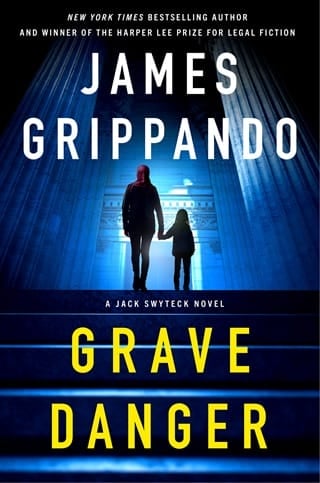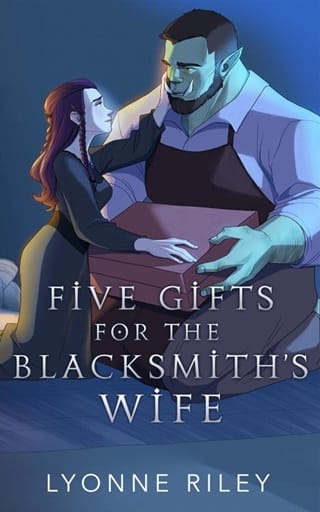Chapter 28
“I’m a terrible mother.”
Jack and Zahra were alone in the conference room. It was the third time Zahra had proclaimed herself the world’s worst mother
since the court-appointed psychiatrist had come for Yasmin and taken her down the hallway to see Judge Carlton.
“It’s the right decision,” said Jack.
“Yasmin turns seven today. We’re doing this on her birthday.”
“I wish you had told me that,” said Jack.
“Oh, I’m sure that would have made a huge difference,” she said with heavy sarcasm. “As if the judge has been showing every
willingness to accommodate our personal lives.”
There was a quick knock on the door, and the judge’s assistant entered.
“It’s time,” she said.
Under Judge Carlton’s instruction, the lawyers were to wait with their clients while the judge and Yasmin got acquainted.
He’d borrowed his granddaughter’s dolls, Lego kit, and other age-appropriate toys to put her at ease. When the psychiatrist
decided that Yasmin was ready to talk about matters pertinent to the case, the lawyers alone—allegations of abuse made it
unwise to put ex-spouses in the same room—could move to the security center to listen and observe by surveillance camera.
A US Marshal met Jack and Farid’s counsel outside the judge’s chambers and led them down one flight of stairs to the courthouse’s security control center. It was a rectangular room with no windows. Long tables lined three of the four walls in a U shape. A row of flat-panel monitors rested on the tabletops. Another row of smaller monitors was suspended from the ceiling. Each monitor displayed a different view of the inside and outside of the courthouse. The marshal directed the lawyers’ attention to the view of Judge Carlton’s chambers on one of the larger monitors.
“There’s no mic in here,” said the marshal. “You can hear, but the judge won’t hear you.”
Jack turned his full attention to the monitor.
The judge, as promised, was not wearing his robe. He’d even removed his necktie, opting for a casual open collar. They were
away from his desk in the sitting area of his private chambers. An assortment of toys covered the coffee table. Yasmin was
on her knees, paying full attention to what Jack recognized, thanks to Righley, as an American Girl doll. Samantha, if he
was not mistaken. Yasmin seemed quite comfortable and content, as far as Jack could tell. The judge was nearby, seated in
the armchair. It was Jack’s understanding that the court-appointed psychiatrist was in the room to observe, but she was off
camera,
“When my daughter comes to visit, she likes to draw pictures,” the judge said.
Yasmin’s focus remained on the doll.
“Do you like to draw pictures, Yasmin?”
She didn’t look at him, but she nodded shyly.
The judge rose and stepped off camera for a moment. He returned with several sheets of blank paper and a box of crayons, which
he placed on the coffee table. They immediately caught Yasmin’s attention.
“Go right ahead,” said the judge. “Draw anything you like.”
Yasmin laid the doll aside. She opened the box of crayons, selected a handful of colors, and started drawing.
Jack leaned a little closer to the monitor for a better look, and so did his opposing counsel. But he couldn’t tell what Yasmin
was drawing.
Yasmin drew in silence for several minutes, choosing more colors as the work progressed. The judge didn’t interrupt, speaking
only when it was clear that she was finished.
“Can I see it?” the judge asked.
She nodded and handed it up to him.
The judge examined it and smiled. “This is really good, Yasmin.”
“Thank you,” she said, though her voice was barely audible over the speaker.
“Is this your school?” the judge asked.
“Yes.”
“And that’s the American flag, right?”
“Uh-huh.”
“Who are these people by the flagpole?”
“My friends.”
“Do you like school, Yasmin?”
“Yes.”
“Do you feel safe at your school?”
She nodded.
The judge laid the drawing aside, then sat forward on his chair, getting a little closer. “Could you do me a favor, Yasmin?”
“Okay.”
“Can you draw me a picture of your family?”
Jack presumed that the psychiatrist had scripted that question.
Yasmin nodded. She took another piece of paper and chose another set of crayons. The judge waited patiently as she drew, again
saying nothing to steer or influence her art. Jack watched the monitor, still unable to see what she was drawing. Several
minutes passed. When finished, she handed her drawing to the judge. Judge Carlton examined it. Jack tried to read his expression,
but it revealed nothing.
“Another splendid drawing,” the judge said.
“Thank you.”
“I’m going to step away for just a minute,” the judge said. “You can stay right here and keep drawing.”
“What should I draw?”
“Draw whatever you like,” he said, rising. “I’ll be right back.”
Yasmin helped herself to a blank sheet of paper. The judge stepped away, but the camera did not follow him. The image on the monitor was Yasmin alone at the coffee table, drawing. A moment later, the marshal directed the lawyers’ attention to another screen. Judge Carlton was in a different room with the forensic psychiatrist. The judge faced the camera and spoke to the lawyers.
“Counsel, I am going to share Yasmin’s drawing with the forensic psychiatrist. You may observe, but please do not comment
or interrupt.”
Jack understood the rules. He watched as the psychiatrist examined the drawing of Yasmin’s “family.” Finally, the psychiatrist
shared her thoughts.
“For the benefit of counsel, I note that Yasmin’s drawing of her family contains only two people. A girl, whom she labeled
‘me,’ and a woman, who is labeled ‘Mommy.’”
Jack took that as a positive development. A drawing of a “family” without Mommy would have been devastating to Zahra’s case.
The psychiatrist continued. “I find it noteworthy that the mommy in this drawing has short hair. Zahra Bazzi has long hair,
so I must assume that the mommy with short hair is Ava Bazzi.”
“What do you make of that, Doctor?” the judge asked.
“Even if we assume that Ava had short hair for only a few days after she cut it in protest of the hijab laws, that was obviously
a traumatic episode for her daughter. The image of Ava with short hair is burned into Yasmin’s memory of her mother, even
though she is very young. The upshot is that Yasmin still thinks of Ava as ‘mommy,’ even though she has been with Zahra for
nearly a year.”
Jack would have preferred a drawing with Zahra as “Mommy,” but it certainly wasn’t helpful to Farid’s case that there was
no father in the family—which was precisely the judge’s next question.
“Is it significant that Farid Bazzi is not in the picture?”
The psychiatrist paused, then responded. “It is understandable that a girl of Yasmin’s age would not include her father in
the drawing of her family. Farid has been out of her life completely since she was five years old. While Zahra may have shared
photographs or other items to remind Yasmin that Ava was her ‘mommy,’ it seems doubtful under the circumstances that Zahra
would have shared anything with Yasmin to remind her that Farid is her father.”
It seemed to Jack that the psychiatrist went further than necessary to explain Farid’s absence from the drawing, but there was nothing he could do to challenge her opinion under the judge’s rules in this informal setting.
“All right,” said the judge. “I don’t want to leave Yasmin alone too long. I’m returning to my chambers now.”
Jack and his opposing counsel turned their attention back to the other monitor. Yasmin was busy drawing. Just as the judge
reappeared on camera, she pulled the drawing from the table and tried to hide it in her lap. The judge noticed.
“What you got there, Yasmin?” the judge asked.
“Nothing.”
“Come on,” he said, smiling. “You can show me.”
“No.”
Jack’s interest was piqued, and he was not alone.
“Yasmin, it’s okay,” the judge said. “You can show me anything. No one ever gets in trouble here.”
Jack knew that was a lie, but it did the trick. Slowly, and with obvious reluctance, Yasmin handed the judge her drawing.
Jack couldn’t see the drawing. But he could read the expression on Judge Carlton’s face. It conveyed nothing short of alarm.
“Yasmin, I’ll be right back,” the judge said, and he stepped out of view, taking Yasmin’s drawing with him.
Yasmin was alone on the monitor for less than a minute, until the judge returned with the psychiatrist. The audio didn’t pick
up the conversation for Jack to hear, but Yasmin left the room with the psychiatrist. The judge then turned to the camera
and spoke to the lawyers, presumably out of earshot from Yasmin.
“Counsel, I have shared Yasmin’s third drawing with the forensic psychiatrist. It is my view that this informal, off-the-record
conversation with Yasmin is not the appropriate way in which to explore the meaning and possible trauma behind this drawing.”
The judge paused, and Jack, too, felt the need to catch his breath. The judge continued.
“I therefore ask that the lawyers and their clients gather in my courtroom. I will then show you the drawing and make a formal determination of how to proceed. That is all for now.”
The marshal switched off the monitor, and the screen went black. Jack and his opposing counsel exchanged a quick glance.
“Interesting,” said Beech. “Hard to tell if this is going to be bad for your client or mine.”
Jack didn’t answer. His thoughts were with Yasmin, and what terrible image had come from her innocent mind.
 Fullepub
Fullepub 



